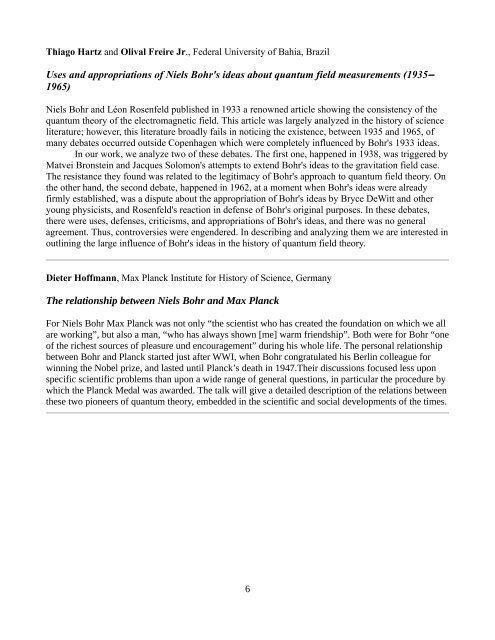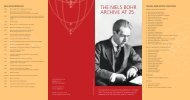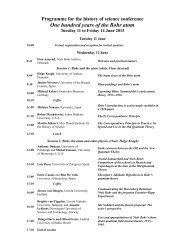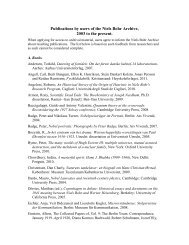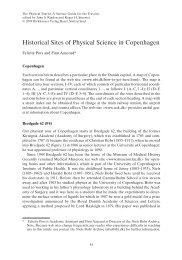Love and physics: Margrethe Nørlund and Niels Bohr's creativity ...
Love and physics: Margrethe Nørlund and Niels Bohr's creativity ...
Love and physics: Margrethe Nørlund and Niels Bohr's creativity ...
You also want an ePaper? Increase the reach of your titles
YUMPU automatically turns print PDFs into web optimized ePapers that Google loves.
Thiago Hartz <strong>and</strong> Olival Freire Jr., Federal University of Bahia, Brazil<br />
Uses <strong>and</strong> appropriations of <strong>Niels</strong> <strong>Bohr's</strong> ideas about quantum field measurements (1935‒<br />
1965)<br />
<strong>Niels</strong> Bohr <strong>and</strong> Léon Rosenfeld published in 1933 a renowned article showing the consistency of the<br />
quantum theory of the electromagnetic field. This article was largely analyzed in the history of science<br />
literature; however, this literature broadly fails in noticing the existence, between 1935 <strong>and</strong> 1965, of<br />
many debates occurred outside Copenhagen which were completely influenced by <strong>Bohr's</strong> 1933 ideas.<br />
In our work, we analyze two of these debates. The first one, happened in 1938, was triggered by<br />
Matvei Bronstein <strong>and</strong> Jacques Solomon's attempts to extend <strong>Bohr's</strong> ideas to the gravitation field case.<br />
The resistance they found was related to the legitimacy of <strong>Bohr's</strong> approach to quantum field theory. On<br />
the other h<strong>and</strong>, the second debate, happened in 1962, at a moment when <strong>Bohr's</strong> ideas were already<br />
firmly established, was a dispute about the appropriation of <strong>Bohr's</strong> ideas by Bryce DeWitt <strong>and</strong> other<br />
young physicists, <strong>and</strong> Rosenfeld's reaction in defense of <strong>Bohr's</strong> original purposes. In these debates,<br />
there were uses, defenses, criticisms, <strong>and</strong> appropriations of <strong>Bohr's</strong> ideas, <strong>and</strong> there was no general<br />
agreement. Thus, controversies were engendered. In describing <strong>and</strong> analyzing them we are interested in<br />
outlining the large influence of <strong>Bohr's</strong> ideas in the history of quantum field theory.<br />
Dieter Hoffmann, Max Planck Institute for History of Science, Germany<br />
The relationship between <strong>Niels</strong> Bohr <strong>and</strong> Max Planck<br />
For <strong>Niels</strong> Bohr Max Planck was not only “the scientist who has created the foundation on which we all<br />
are working”, but also a man, “who has always shown [me] warm friendship”. Both were for Bohr “one<br />
of the richest sources of pleasure und encouragement” during his whole life. The personal relationship<br />
between Bohr <strong>and</strong> Planck started just after WWI, when Bohr congratulated his Berlin colleague for<br />
winning the Nobel prize, <strong>and</strong> lasted until Planck’s death in 1947.Their discussions focused less upon<br />
specific scientific problems than upon a wide range of general questions, in particular the procedure by<br />
which the Planck Medal was awarded. The talk will give a detailed description of the relations between<br />
these two pioneers of quantum theory, embedded in the scientific <strong>and</strong> social developments of the times.<br />
6


